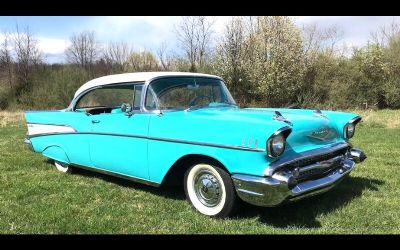Welcome to the ultimate source for Classic & Muscle Car Research.
 The 1955 to 1957 Chevrolet models, commonly referred to as the "Tri-Five" Chevys, are some of the most iconic and celebrated cars in American automotive history.
The 1955 to 1957 Chevrolet models, commonly referred to as the "Tri-Five" Chevys, are some of the most iconic and celebrated cars in American automotive history.
Introduced in 1955, these models marked a significant departure from Chevrolet's previous designs and established a new era of post-war car styling. They featured a more modern and distinct appearance with a "shoebox" body design, crisp lines, and a wide, low stance.
The 1955 Chevrolet introduced the all-new "Small-Block" V8 engine, which would become legendary for its durability, performance, and versatility. This engine significantly enhanced the car's power and performance, making the '55 Chevy a favorite among enthusiasts and racers.
In 1956, the Tri-Five Chevys received subtle updates, including a revised front end and new tail lights. The interior was refined for added comfort, and various trim levels and body styles were offered, including two-door sedans, convertibles, and sporty hardtops.
The 1957 models were the pinnacle of the Tri-Five era. They featured bold styling updates, including a more prominent grille, distinctive hood rockets, and larger tail fins. The '57 Chevy also offered a fuel-injected version of the Small-Block V8, which was one of the first mass-produced fuel-injection systems in an American car.
The Tri-Five Chevys gained immense popularity for their timeless design, reliability, and performance capabilities. They became iconic symbols of the 1950s car culture and remain highly sought-after classics among collectors and enthusiasts worldwide. Their enduring appeal and significance in automotive history have solidified their status as true American classics.
The 1955-1957 Chevrolet Bel Air has made numerous appearances in movies and television shows over the years due to its iconic design and cultural significance. It's often used to evoke a sense of nostalgia and capture the spirit of a bygone era. Here are some notable examples of its appearances in media:
American Graffiti (1973): This coming-of-age film directed by George Lucas is set in the early 1960s and features several classic cars, including the 1955 Chevrolet Bel Air.
Two-Lane Blacktop (1971): This road movie showcases a cross-country race between a 1955 Chevy and a 1970 Pontiac GTO. The Bel Air is a prominent vehicle in the film.
Grease (1978): In this musical, the character Kenickie drives a 1957 Chevrolet Bel Air convertible.
Christine (1983): While the main focus of this horror film is a 1958 Plymouth Fury, there is a scene featuring a 1957 Chevrolet Bel Air.
Stand by Me (1986): This adaptation of a Stephen King novella features a flashback scene involving a 1956 Chevrolet Bel Air.
Rain Man (1988): A 1957 Chevrolet Bel Air convertible is featured in this film as one of the cars owned by the character Raymond.
Pulp Fiction (1994): A 1955 Chevrolet Bel Air is used in a few scenes in Quentin Tarantino's iconic film.
Happy Days (TV Series, 1974-1984): While not a movie, the 1955-1957 Chevrolet Bel Air was frequently seen on this television show, which was set in the 1950s and 1960s.
La La Land (2016): In this modern musical, the characters perform a dance sequence on a hill overlooking Los Angeles with a 1955 Chevrolet Bel Air.
Drive (2011): Though not the central focus of the film, a 1955 Chevrolet Bel Air makes an appearance in this neo-noir crime thriller.
These are just a few examples of the many appearances of the 1955-1957 Chevrolet Bel Air in movies and TV shows. Its timeless design and cultural significance continue to make it a popular choice for filmmakers looking to capture the essence of past decades.
1955 Chevrolet Bel Air:
Total Chevrolet production in 1955: Approximately 1,704,667 units.
Bel Air accounted for a significant portion of this production but exact figures vary by source. An estimated range for Bel Air production is around 374,000 to 820,000 units.
1956 Chevrolet Bel Air:
Total Chevrolet production in 1956: Approximately 1,567,117 units.
Similar to 1955, the Bel Air was a popular model, but exact figures vary. Bel Air production for this year is estimated to be around 41% of total Chevrolet production, which would be roughly 644,000 units.
1957 Chevrolet Bel Air:
Total Chevrolet production in 1957: Approximately 1,526,690 units.
The Bel Air continued to be a prominent model, with estimates suggesting that around 38% of total Chevrolet production was Bel Air models. This would translate to approximately 579,000 units.
'57 Bel Air Resto Mod
'56 Bel Air
'56 Bel Air Pro Tour
'55 Bel Air Wagon
'55 Bel Air Coupe
'57 Bel Air
'57 Bel Air Sport Coupe Custom
'57 Bel Air Fuelie
Advertise Now!





